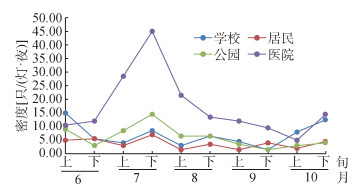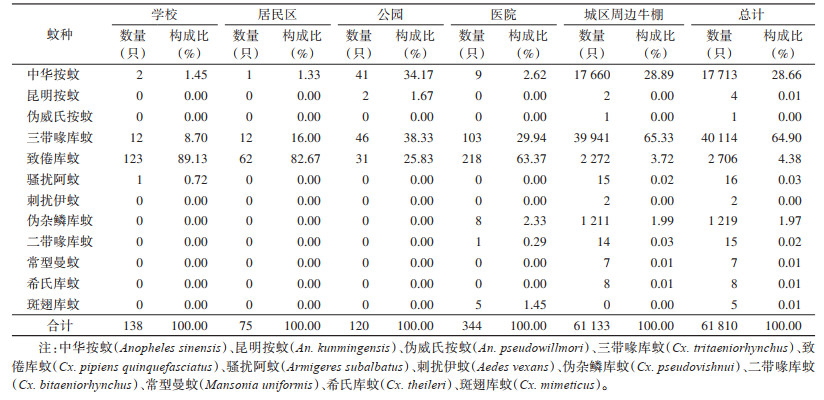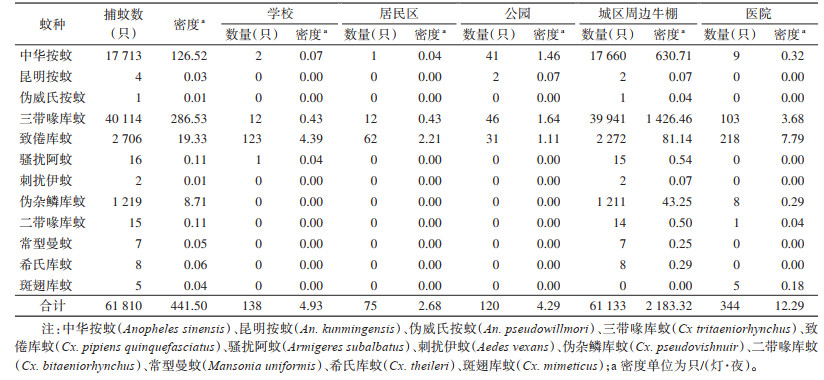引用本文 | 0 |
李希尚, 王加志, 李胜国, 汤宗艳, 杨东海, 尹授钦, 王兴娟, 李增助, 蔡文斌. 云南省腾冲市城区2018-2020年蚊虫调查分析[J]. 中国媒介生物学及控制杂志, 2022, 33(3): 356-359.

LI Xi-shang, WANG Jia-zhi, LI Sheng-guo, TANG Zong-yan, YANG Dong-hai, YIN Shou-qin, WANG Xing-juan, LI Zeng-zhu, CAI Wen-bin. An investigation of mosquitoes in urban Tengchong, Yunnan province, China, 2018-2020[J]. Chin J Vector Biol & Control, 2022, 33(3): 356-359.

云南省腾冲市城区2018-2020年蚊虫调查分析
李希尚

,
王加志
,
李胜国
,
汤宗艳
,
杨东海
,
尹授钦
,
王兴娟
,
李增助
,
蔡文斌


腾冲市疾病预防控制中心地方病防治科, 云南 腾冲 679100
收稿日期: 2021-12-30
基金项目: 云南省万人计划名医专项;云南省高层次卫生健康技术人才培养专项经费(H-2019030);云南省保山市高层次创新人才计划项目(202015)
摘要: 目的 掌握云南省腾冲市城区蚊种构成和空间分布、种群密度及季节消长情况,为蚊虫防治提供科学依据。方法 采用诱蚊灯法进行成蚊调查,布雷图指数(BI)法进行伊蚊幼虫调查,使用F、χ2(或Fisher确切概率法)检验对调查结果进行统计分析。结果 2018-2020年共捕获成蚊5属12种61 810只,城区优势蚊种为致倦库蚊和三带喙库蚊,城市周边地区优势蚊种为中华按蚊和三带喙库蚊。城区周边牛棚蚊虫平均密度为2 183.32只/(灯·夜),医院、学校、公园和居民区分别为12.29、4.93、4.29和2.68只/(灯·夜),伊蚊幼蚊调查11 986个容器,阳性容器80个,均为白纹伊蚊幼蚊,平均BI为0.66。结论 初步掌握了腾冲市城区蚊种构成和空间分布、种群密度、季节消长情况,进行蚊虫防制时,应根据蚊虫密度季节消长情况及蚊虫孳生环境类型,采取不同的控制措施。
关键词:
蚊虫 密度 季节消长 分析
An investigation of mosquitoes in urban Tengchong, Yunnan province, China, 2018-2020
LI Xi-shang

,
WANG Jia-zhi
,
LI Sheng-guo
,
TANG Zong-yan
,
YANG Dong-hai
,
YIN Shou-qin
,
WANG Xing-juan
,
LI Zeng-zhu
,
CAI Wen-bin


Department of Endemic Disease Control, Tengchong Center for Disease Control and Prevention, Tengchong, Yunnan 679100, China
Fund program: Special Project for Famous Doctors of Yunnan 10000 Person Plan; Special Fund for Training High-level Health Technical Personnel in Yunnan Province (No. H-2019030); Baoshan High Level Innovative Talents Program (No. 202015)
Abstract: Objective To investigate the species composition, spatial distribution, population density, and seasonal fluctuation of mosquitoes in the urban area of Tengchong, Yunnan province, China, and to provide a scientific basis for mosquito prevention and control. Methods Adult mosquitoes were captured by the light trap method. Aedes albopictus larvae were investigated using the Breteau index (BI). The F test and Chi-squared test (or Fisher's exact test) were used for data analysis. Results A total of 61 810 adult mosquitoes were captured from 2018 to 2020, involving 12 species of 5 genera. The dominant species were Culex pipiens quinquefasciatus and Cx. tritaeniorhynchus in the urban area, and Anopheles sinensis and Cx. tritaeniorhynchus in the suburban area. The average mosquito density was 2 183.32 mosquitoes/light·night in cattle sheds in the suburban area, 12.29 mosquitoes/light·night in hospitals, 4.93 mosquitoes/light·night in schools, 4.29 mosquitoes/light·night in parks, and 2.68 mosquitoes/light·night in residential areas. A total of 11 986 containers were examined for Aedes larvae. There were 80 positive containers, all of which were positive for Ae. albopictus larvae. The average BI was 0.66. Conclusion The species composition, spatial distribution, population density, and seasonal fluctuation of mosquitoes in the urban area of Tengchong are preliminarily understood. Control measures should depend on the seasonal fluctuation of mosquito density and the breeding environment of mosquito.
Key words:
Mosquito Density Seasonal fluctuation Analysis
蚊虫不仅骚扰吸血,还可传播流行性乙型脑炎(乙脑)、疟疾、登革热、寨卡病毒病和西尼罗病毒病等蚊媒传染病,严重威胁人类健康[1-2]。腾冲市位于云南省西部,与缅甸相邻,地处24°38′~25°52′N,98°05′~98°45′E,年平均降雨量1 531 mm,年平均气温15.1 ℃,城区海拔为1 640 m,生态环境优越。近年来,腾冲市有疟疾、登革热、基孔肯雅热等输入蚊媒传染病报告,且疟疾输入病例较多[3-5]。为了解腾冲市城区蚊种构成和空间分布、种群密度、季节消长情况,我们于2018-2020年定期对腾冲市城区开展蚊虫监测,以便为虫媒传染病防控提供参考依据。
1 材料与方法
1.1 监测地点 随机选取腾冲市城区内居民区、医院、学校、公园和城区周边地区牛棚为成蚊监测点,每个监测点布放1台诱蚊灯。按地理方位(东、西、南、北)将城市分为4个调查区,采用布雷图指数(BI)法进行伊蚊幼虫调查。
1.2 监测时间 2018-2020年,每年6-10月,每月上、下旬进行成蚊调查。每年12月-次年4月每月上旬或下旬,5-11月每月上、下旬采用BI法对伊蚊幼蚊进行调查。
1.3 监测方法 参照《病媒生物密度监测方法蚊虫》(GB/T 23797-2009)开展成蚊调查,每处生境放置功夫小帅诱蚊灯1台,日落前1 h接通电源,开启诱蚊灯,次日天亮后1 h收灯,将所获蚊虫带回实验室,于-20 ℃冰箱冷冻处死,进行成蚊分类鉴定。参照《全国登革热媒介监测技术指南》开展登革热媒介伊蚊幼虫调查,每个调查区每次调查随机选取不少于50户,调查居民户内积水容器,有媒介伊蚊幼蚊及蛹孳生容器记为阳性,采集阳性容器内幼蚊,带回实验室进行蚊种鉴定[6],并记录,计算公式如下:
1.4 统计学分析 利用Excel 2021和SPSS 25.0软件对数据进行整理分析,计量资料的比较采用方差分析,计数资料的比较采用χ2(或Fisher确切概率法)检验,P < 0.05为差异有统计学意义。
2 结果
2.1 不同生境蚊虫种类构成 腾冲市2018-2020年城区共捕获成蚊5属12种61 810只。学校优势蚊种为致倦库蚊(Culex pipiens quinquefasciatus),占捕获总数的89.13%;居民区优势蚊种为致倦库蚊和三带喙库蚊(Cx. tritaeniorhynchus),分别占82.67%和16.00%;公园优势蚊种为三带喙库蚊、中华按蚊和致倦库蚊,分别占38.33%、34.17%和25.83%;医院优势蚊种分别为致倦库蚊和三带喙库蚊,分别占63.37%和29.94%;城区周边牛棚优势蚊种为三带喙库蚊和中华按蚊(Anopheles sinensis),分别占65.33%和28.89%(表 1)。不同生境蚊种构成比较,采用Fisher确切概率法检验,差异有统计学意义(P < 0.05)。
表 1 云南省腾冲市城区2018-2020年不同生境蚊种构成
Table 1 Mosquito species composition in different habitats in urban Tengchong, Yunnan province, 2018-2020
2.2 不同生境蚊虫密度 腾冲市城区2018-2020年不同生境蚊虫成蚊平均密度以城区周边牛棚最高,为2 183.32只/(灯·夜),其他依次为医院、学校、公园和居民区,平均密度分别为12.29、4.93、4.29和2.68只/(灯·夜)(表 2)。不同生境中华按蚊、致倦库蚊、三带喙库蚊密度差异无统计学意义(F=3.210,P > 0.05)。
表 2 云南省腾冲市城区2018-2020年不同生境蚊虫密度分布情况
Table 2 Mosquito density distribution in different habitats in urban Tengchong, Yunnan province, 2018-2020
2.3 不同生境蚊虫密度季节消长 2018-2020年公园、医院、居民区、城区周边牛棚捕获成蚊平均密度季节消长趋势呈单峰分布,蚊平均密度从6月下旬开始上升,高峰在7月下旬,9月下旬明显下降,平均密度高峰分别为14.50、45.00、7.00和10 375.00只/(灯·夜)。学校蚊平均密度高峰为6月上旬、7月下旬和10月下旬,分别为15.00、8.50和12.50只/(灯·夜)(图 1、2)。不同生境蚊虫密度季节消长趋势差异有统计学意义(χ2=72.443,P < 0.05)。
2.4 登革热媒介幼蚊调查 2018-2020共调查12 107户,11 986个容器,阳性容器80个,发现阳性伊蚊容器均在城区周边城乡结合部废旧轮胎收购销售点,经鉴定均为白纹伊蚊(Aedes albopictus)幼蚊,未发现埃及伊蚊(Ae. aegypti)幼蚊。伊蚊平均BI为0.66,废旧轮胎阳性率为3.49%(80/2 289)(表 3)。不同年份间BI差异有统计学意义(χ2=20.329,P < 0.05)。
表 3 云南省腾冲市2018-2020年城区伊蚊幼蚊调查结果
Table 3 Data on Aedes larvae in urban Tengchong, Yunnan province, 2018-2020
3 讨论 2008-2020年腾冲市城区蚊虫监测结果显示,优势蚊种为致倦库蚊和三带喙库蚊,以致倦库蚊为主要优势种,与我国城市居民区蚊虫种类以淡色库蚊/致倦库蚊为主的结论相一致[7-8]。与致倦库蚊幼蚊孳生地广泛相关[6],城市中的臭水沟、雨水井等污染水体,为致倦库蚊提供了良好孳生地。城区周边地区以中华按蚊、三带喙库蚊为优势种,城区周边存在白纹伊蚊幼蚊,与以往调查相一致[4, 9]。三带喙库蚊为腾冲市城区次要优势蚊种,可能与腾冲市城区周边主要以稻田为主,三带喙库蚊幼蚊主要孳生于稻田、池塘、沼泽等有关。提示城区存在乙脑等虫媒传染病引起本地传播风险,城市周边地区存在输入性疟疾、登革热、基孔肯雅热、乙脑等虫媒传染病引起本地传播的风险。
蚊虫密度与气温、降雨量等气象因素密切相关[2, 10],腾冲市蚊虫平均密度变化与腾冲市城区温度及降雨量密切相关,6月温度升高,降雨增加,9月后温度降低,降雨减少, 提示在蚊虫密度高峰季节(6-9月)应以蚊虫密度控制和孳生地治理为主,其他月份以孳生地治理为主。城市周边牛棚本次调查与以往调查相比密度明显升高[9],可能与本次选择的调查点周围有丰富的孳生地稻田和牛棚内有大量蚊虫吸血宿主水牛有关。不同生境蚊虫密度季节消长及蚊虫构成结果提示,在进行蚊虫孳生地治理时,应对不同生境提出不同治理措施,加强阴沟、低洼、瓶罐、桶、废旧轮胎等积水容器处理,清除不同生境蚊虫孳生地,加强城乡结合部蚊虫孳生地治理工作。
通过本次调查, 初步掌握了腾冲市城区蚊种构成和空间分布、种群密度、季节消长,为控制蚊虫及蚊媒传染病防治提供了科学依据。在蚊虫控制工作中应以“国家文明、卫生城市和云南省七个专项行动”为契机,采取政府主导为主,多部门协作,社区网格化管理,全民参与的防控模式。以监测结果为依据,科学用药,控制蚊虫密度,控制虫媒传染病发生,减少蚊虫侵害,提高居民生活质量。
利益冲突 无
参考文献
| [1] |
张伟, 蒋峥, 邓良利, 等. 2013-2017年成都市蚊虫密度监测分析[J]. 中华卫生杀虫药械, 2021, 27(1): 45-47. Zhang W, Jiang Z, Deng LL, et al. Surveillance of mosquitoes in Chengdu city from 2013 to 2017[J]. Chin J Hyg Insect Equip, 2021, 27(1): 45-47. DOI:10.19821/j.1671-2781.2021.01.012 |
|
| [2] |
马卓, 魏绪强, 阙燃. 2014-2016年北京市东城区蚊密度监测分析[J]. 中华卫生杀虫药械, 2021, 27(2): 129-131. Ma Z, Wei XQ, Que R. Analysis on the mosquito density in Dongcheng district of Beijing from 2014 to 2016[J]. Chin J Hyg Insect Equip, 2021, 27(2): 129-131. DOI:10.19821/j.1671-2781.2021.02.010 |
|
| [3] |
王加志, 李胜国, 李希尚, 等. 2010-2015年腾冲市疟疾疫情流行病学分析[J]. 中国血吸虫病防治杂志, 2016, 28(5): 566-568. Wang JZ, Li SG, Li XS, et al. Malaria epidemiological analysis in Tengchong city from 2010 to 2015[J]. Chin J Schisto Control, 2016, 28(5): 566-568. DOI:10.16250/j.32.1374.2015254 |
|
| [4] |
王加志, 汤宗艳, 尹授钦, 等. 云南省腾冲市2014-2017年登革热媒介伊蚊监测结果分析[J]. 中国媒介生物学及控制杂志, 2019, 30(2): 206-208. Wang JZ, Tang ZY, Yin SQ, et al. An analysis of the surveillance results of dengue vector Aedes in Tengchong, Yunnan province, from 2014 to 2017[J]. Chin J Vector Biol Control, 2019, 30(2): 206-208. DOI:10.11853/j.issn.1003.8280.2019.02.022 |
|
| [5] |
李希尚, 郭超, 康显虎, 等. 云南省腾冲市首例输入性基孔肯雅热病例的调查处置[J]. 中国热带医学, 2020, 20(1): 84-86. Li XS, Guo C, Kang XH, et al. Investigation and response of the first imported Chikungunya fever case in Tengchong, Yunnan[J]. China Trop Med, 2020, 20(1): 84-86. DOI:10.13604/j.cnki.46-1064/r.2020.01.20 |
|
| [6] |
董学书, 周红宁, 龚正达. 云南蚊类志(下卷)[M]. 昆明: 云南科技出版社, 2010: 60-61, 246-248.
Dong XS, Zhou HN, Gong ZD. The annals of Yunnan mosquitoe. Volume 2[M]. . Kunming: Yunnan Science and Technology Press, 2010: 60-61, 246-248.
|
|
| [7] |
郭玉红, 吴海霞, 刘小波, 等. 2018年全国媒介蚊虫监测报告[J]. 中国媒介生物学及控制杂志, 2019, 30(2): 128-133. Guo YH, Wu HX, Liu XB, et al. National vectors surveillance report on mosquitoes in China, 2018[J]. Chin J Vector Biol Control, 2019, 30(2): 128-133. DOI:10.11853/j.issn.1003.8280.2019.02.003 |
|
| [8] |
赵宁, 郭玉红, 吴海霞, 等. 2019年全国媒介蚊虫监测报告[J]. 中国媒介生物学及控制杂志, 2020, 31(4): 395-400, 406. Zhao N, Guo YH, Wu HX, et al. National vector surveillance report on mosquitoes in China, 2019[J]. Chin J Vector Biol Control, 2020, 31(4): 395-400, 406. DOI:10.11853/j.issn.1003.8280.2020.04.003 |
|
| [9] |
李希尚, 李胜国, 王加志, 等. 云南省腾冲市2012-2013年蚊媒调查分析[J]. 中国媒介生物学及控制杂志, 2016, 27(4): 398-401. Li XS, Li SG, Wang JZ, et al. Analysis on mosquito survey in Tengchong of Yunnan from 2012 to 2013[J]. Chin J Vector Biol Control, 2016, 27(4): 398-401. DOI:10.11853/j.issn.1003.8280.2016.04.023 |
|
| [10] |
谢博, 冯磊, 顾盈培, 等. 气候因素对浦东新区蚊虫密度影响的效应分析[J]. 中国媒介生物学及控制杂志, 2019, 30(4): 430-433. Xie B, Feng L, Gu YP, et al. An analysis of the effect of climatic factors on mosquito density in Pudong new area, Shanghai, China[J]. Chin J Vector Biol Control, 2019, 30(4): 430-433. DOI:10.11853/j.issn.1003.8280.2019.04.017 |
|
 2022, Vol. 33
2022, Vol. 33












